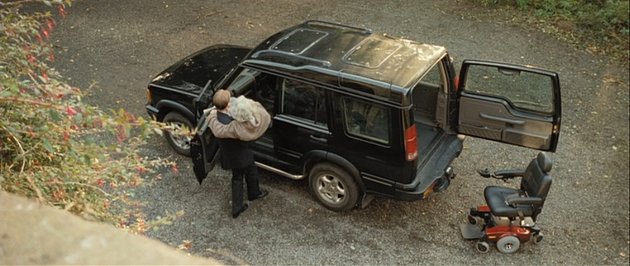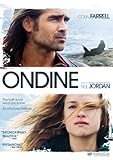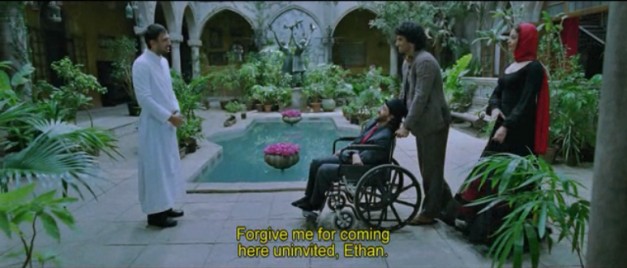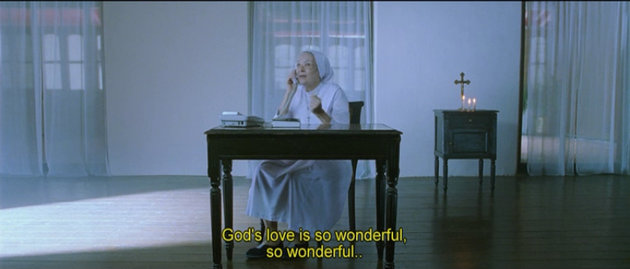The video for the single Catch Me from the debut album of the self-described “artistic pop visionary band” BRAVES features actor Matthew Lillard interacting with a physically disabled man. Doctor Victor Pineda holds a Masters degree in regional economic development and a PhD in urban planning, uses noninvasive mechanical ventilation, and has addressed the World Bank in a call for radical inclusion of people with disabilities. And now he has a new career as a music video dancer. Who knew?
Honey Maid: How to Make Apple and Cheddar Melts
Blink and you’ll miss it, but the latest Honey Maid commercial in their “This is Wholesome” series features a motorized wheelchair-using adult woman teaching a young girl how to use the microwave to make herself a snack. It’s almost a good example of including a person with a disability in a parental role, but falls just short as the captions identify the woman as the girl’s aunt instead of her mother. Way to dispel the stereotype that wheelchair users can’t have kids, Honey Maid. But at least the ad features a genuine disabled person, not an able-bodied person pretending to be disabled!
The aunt in the ad is Stephanie Woodward, a disability rights lawyer and activist who is currently director of advocacy at The Center for Disability Rights. She signed on for the project, Honey Maid says, because she—and many in the disabled community—want real disabled people featured on TV and in the media, not actors playing disabled people.
Woodward was also drawn to the simple realism of the ad in a media landscape where disabled people are often portrayed “in either a pity or a superhero light.” (By the way, while there is much debate around the language of disability, Woodward prefers the term disabled person to person with a disability. “I am a proud disabled woman and prefer not to identify with ‘people first’ language as it separates me from my disability identity,” she says.)
The latest spot coincides with this weekend’s 25th anniversary of the signing into law of 1990’s Americans With Disabilities Act. Honey Maid says the ad is also one of the first to include audio descriptions on the 15-second TV version—describing what’s happening on screen for blind and low-vision audiences—along with standard closed captioning.
The audio description spots will air on NBC and ABC networks only (NBC, Bravo, E!, Oxygen, ABC). The general spot will air on Nick@Nite, Lifetime, LMN and CBS.
Read more at AdWeek: http://www.adweek.com/adfreak/honey-maids-latest-wholesome-family-features-disabled-aunt-and-her-niece-166102
Wild Target
 Victor Maynard of Wild Target was born to be a hit man; taught the family trade by his father and his career nurtured by his formidable mother Louisa. Louisa lived with him in the large ancestral home until recently, when (though there was an old-fashioned lift installed in the house for her wheelchair) she moved to an assisted living facility in London. Victor visits her regularly, where she is apparently still ruling the roost, dressing elegantly, serving tea, and keeping close tabs on her son’s career and (lack of) love life.
Victor Maynard of Wild Target was born to be a hit man; taught the family trade by his father and his career nurtured by his formidable mother Louisa. Louisa lived with him in the large ancestral home until recently, when (though there was an old-fashioned lift installed in the house for her wheelchair) she moved to an assisted living facility in London. Victor visits her regularly, where she is apparently still ruling the roost, dressing elegantly, serving tea, and keeping close tabs on her son’s career and (lack of) love life.
Victor isn’t terribly put off by his mother’s badgering as the years invested in such a solitary profession are beginning to take their toll. He falls for a woman he’s been hired to kill, an art thief much younger and prettier than he. When he finds himself unable to kill her, he takes on the job of her protector instead and brings her to the family estate in the countryside.
Mother advises him to apologize to his employer and finish the job for free lest he become a target himself, but when she gets wind of Rose’s whereabouts she becomes concerned that Victor is losing focus. Louisa takes a wheelchair-accessible taxi from her assisted-living facility to the country house, where she (no doubt using the lift) ambushes Rose with a large knife in the middle of the night in her bedroom. When Victor tries to intervene, his mother blows a hole through the door.

Professional killer mom Louisa gets packed off back to her assisted living facility after the wheelchair accessible London cab fleet enables her to attempt a hit on her son's love interest. I don't know about you, but I feel empowered.
Victor is mortified, but Rose forgives him, saying she has a cousin “mad as a balloon… but family is family, right?” Here marks the beginning of Victor’s loosening up; he has a good time at his birthday party, rips the plastic coverings off the furniture, and sleeps with Rose in short order.
Victor still must admit his past to Rose and face the hired guns that took her hostage, but when it comes time for a showdown in the family barn, it’s Louisa who appears on a loft in her electric wheelchair to save the day. (How the heck she got herself up there shall forever remain a mystery.) She kills one of the baddies with a machine gun and gives her son the upper hand, and the hit man and the thief live happily ever after. (Except for the cat.)
Guzaarish
 Guzaarish (Hindi for “Request”) is the Bollywood remake of “Whose Life is it Anyway?”, and yet another example of the “right to die” disability movie trope.
Guzaarish (Hindi for “Request”) is the Bollywood remake of “Whose Life is it Anyway?”, and yet another example of the “right to die” disability movie trope.
The story centers around Ethan Mascarenhas, once a famous magician, who became a quadriplegic when his best friend betrayed him during a dangerous trick. Ethan has seemingly done well as a quad; he wrote a popular book and appears to have toured to promote it, he’s a Radio Jockey of a popular program called Radio Zindagi, has a romantic if gloomy mansion on a hill, two live-in servants and a nurse, and a sip-and-puff motorized wheelchair. From his home-based studio he exhorts his radio listeners to find beauty in their lives and boasts about his program being the most joyful on the air.
That’s why it’s so surprising when, on his 14th anniversary of becoming a quadriplegic, Ethan suddenly announces that he wants to end it all, and instructs his best friend (a lady lawyer) to file a petition with India’s courts for euthanasia. (Or, as he calls it on his radio program, “Ethanasia”.)
He also suddenly begins snapping at his caregivers and even makes a sexually harassing remark or two to Sophia, his nurse. Disabled viewers probably start wondering if Ethan has some underlying mental health issues at this point.
While it is impossible to deny that many people with disabilities–particularly the newly disabled–are indeed suicidal, “right to die” movies such as Guzaarish are problematic because movies are the primary vehicle for the able-bodied to learn about the lives of the disabled. Suicidal tendencies among the disabled are seen as a perfectly rational, and even noble, response to their condition; a movie such as this only reinforces such perceptions. Depression is thus left untreated and available services unapplied for. Studies show that once disabled people are offered adequate services, pain relief, and adaptive equipment to maximize their independence, they become much less likely to be suicidal.
And indeed Guzaarish bears this out; during the court hearing, it is revealed that Ethan’s mansion is mortgaged to the hilt, and he only has enough savings to cover Sophia’s salary for two more months. Further cracks in Ethan’s cheerful facade begin to appear upon examination. He may have a proper motorized wheelchair, but he only uses it in the beginning of the film. The rest of the time, he’s hauled about slumped in an ill-fitting manual wheelchair. Perhaps his town isn’t particularly wheelchair accessible, nor does he seem to have access to an adapted van or paratransit services. But that doesn’t explain why he hasn’t installed himself on the first floor of his mansion instead of the second, nor added ramps about the extensive grounds. Perhaps he wouldn’t be so depressed if he made an effort to get out more than once in a decade?
Any quadriplegic viewing the above image is now wondering why Ethan bothered to go through the court system, when the means of offing himself are already at his disposal. Clearly Ethan is crying for help, and those cries are amplified when he puts Ethanasia up for a vote on his radio program after the courts deny his initial petition. Most callers vote no; a handful, including Ethan’s former lover, crushingly vote yes. If Ethan wasn’t depressed before, he surely is now.
A judge decides to hear Ethan’s case, and even moves the courtroom to the foyer of Ethan’s home to accommodate his trouble getting around. Ethan uses showmanship to lock the prosecutor into a trunk, and when he begs for release before a minute is up, Ethan tries to make the point that the prosecutor couldn’t tolerate being confined for even a minute. The judge still denies his request, but Ethan has one more ace up his sleeve: Sophia.
Sophia and Ethan declare their love for each other, and she agrees to marry and then kill him, damn the consequences. They have the most uncomfortable wedding imaginable, with the groom dressed up on his deathbed insulting his guests one by one. Ethan’s doctor friend nearly leaves, but is convinced to stay. All pile on the bed to wish him farewell. If there’s one thing to be grateful for, it’s that Guzaarish narrowly avoids the disability movie cliche of the disabled character dying onscreen.
Ondine
 Ondine starts out with a fisherman (with the oddly un-Irish name of Syracuse) who plies his trade with a small boat off the coast of Ireland. Him and his fishing boat are necessary elements to the story, because the tale starts when he pulls up a beautiful young woman wearing a bedraggled gray dress in his net. Initially thinking that she’s dead, he at first thinks of reporting his unusual catch to the authorities, but she turns out to be alive but unconscious, and she quickly revives after he gives her CPR. She makes it clear that she doesn’t want contact with anyone else, and being a fisherman in a remote area, who is lucky enough to have inherited a house from his mother near his fishing grounds, he is initially able to accommodate her wish to hide from the world.
Ondine starts out with a fisherman (with the oddly un-Irish name of Syracuse) who plies his trade with a small boat off the coast of Ireland. Him and his fishing boat are necessary elements to the story, because the tale starts when he pulls up a beautiful young woman wearing a bedraggled gray dress in his net. Initially thinking that she’s dead, he at first thinks of reporting his unusual catch to the authorities, but she turns out to be alive but unconscious, and she quickly revives after he gives her CPR. She makes it clear that she doesn’t want contact with anyone else, and being a fisherman in a remote area, who is lucky enough to have inherited a house from his mother near his fishing grounds, he is initially able to accommodate her wish to hide from the world.
He tells only one person about this unusual occurrence: his young daughter, who suffers from kidney failure and uses a wheelchair, had no book to pass the time during a dialysis appointment; to entertain her he tells her about the strange woman he fished from the sea, claiming that this story is a self-created fairy tale. Having just learned about the Scottish folkloric creature, the Selkie, she comes to the conclusion that this woman has to be a Selkie.
When she meets the woman and finds out that she is more than a fairytale, she starts reading up on Selkies and asking the woman questions. The woman gives her name as “Ondine” (implying that she is indeed a water spirit of some sort), and eventually acknowledges some Selkie characteristics and behavior as the movie goes on. Though the woman initially denies it, the girl and later others in the small town start seeing evidence to support the theory that she is a Selkie.
Most convincingly, when Ondine goes out on the fishing boat with Syracuse and sings, his lobster pots and trawling nets become strangely full. Her attempt to conceal something is taken to be an attempt at “burying her seal coat”, and the appearance of a strange and hostile man who wants to force her to go away with him though she wants to stay with Syracuse and is fast establishing a relationship with him is credited to the folklore concerning “the Selkie husband”. The viewer is left to wonder if she is indeed a Selkie or something similar.
While this movie does use the traditional imagery of the cute little disabled kid in the cute little wheelchair heroically enduring repeated dialysis treatments and patiently waiting for a donor kidney, and indulges in the further unreality of making the girl able to walk for some distance when her new motorized wheelchair becomes temporarily disabled after some able-bodied kids ride it into a big puddle, it is more realistic about physical disabilities and the lives of kids who have them than most other pictures involving a disabled juvenile character. This is perhaps because it is not, strictly speaking, a film about a disabled kid, but rather, a film containing a kid who happens to have some unnamed condition that involves kidney failure and the use of a wheelchair in wheelchair-unfriendly small-town Ireland. The first scene depicting the girl in a manual wheelchair shows us that her father routinely rides her straight over high curbs and cobblestones, and carries her into the car, up stairs, etc. Neither wheelchair ramps nor elevators are anywhere in evidence, those in the know are well aware that she can’t be carried like that forever. The girl somehow goes to school and to the local library, apparently others (her mother and stepfather) carry and chauffeur her as well. Nobody seems to have a van with a wheelchair lift; when Anna gets her power chair, she has to drive herself alongside her father’s car to get home. Though she has a normal pre-teen’s preoccupations, such as watching rock groups on TV and curiosity about the budding relationship between Ondine and her father, her life comes with some unusual risks built in: her stepfather looms as a menacing presence whose conduct and contact with her looks suspiciously on the verge of improper and abusive; her biological father got sober only because he realized someone had to be in order to properly fulfill parental responsibilities to her; his fall off the wagon threatens Anna as well as himself.
Ironically, it was an evening at the pub for her mother and stepfather in which both get inebriated and her mother rode in Anna’s power wheelchair which leads to the death of Anna’s stepfather in an unexpected car crash. He turns out to have a donor card and to be a perfect match for a kidney for the girl. This good luck-bad luck situation is attributed to the wish-granting power of the Selkie after the girl had asked the woman to make her better. Unlike in a lot of movies with a disabled character, the wish articulated by the little disabled girl, “make me better”, did not mean “remove the need for a wheelchair” but rather the life-threatening crisis of the kidney failure.
The true identity of “Ondine” remains a mystery until near the end of the movie when a less supernatural theory of how she came to be where and what she is comes to be revealed. We come to realize that Anna has created a bit of a fantasy for herself in order to cope with the tremendous stresses of her illness instead.



